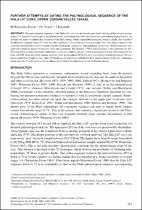 ResearchSpace
ResearchSpace
Further attempts at dating the palynological sequence of the Hula Lo7 core, upper Jordan Valley, Israel
JavaScript is disabled for your browser. Some features of this site may not work without it.
- ResearchSpace
- →
- Research Publications/Outputs
- →
- Journal Articles
- →
- View Item
| dc.contributor.author |
Weinstein-Evron, M

|
en_US |
| dc.contributor.author |
Vogel, JC

|
en_US |
| dc.contributor.author |
Kronfeld, J

|
en_US |
| dc.date.accessioned | 2007-03-26T08:51:04Z | en_US |
| dc.date.accessioned | 2007-06-07T10:02:36Z | |
| dc.date.available | 2007-03-26T08:51:04Z | en_US |
| dc.date.available | 2007-06-07T10:02:36Z | |
| dc.date.copyright | en_US | |
| dc.date.issued | 2001 | en_US |
| dc.identifier.citation | Weinstein-Evron, M, et al. 2001. Further attempts at dating the palynological sequence of the Hula Lo7 core, upper Jordan Valley, Israel. Radiocarbon, vol. 43(2B), pp 561-570 | en_US |
| dc.identifier.issn | 0033-8222 | en_US |
| dc.identifier.uri | http://hdl.handle.net/10204/2035 | en_US |
| dc.identifier.uri | http://hdl.handle.net/10204/2035 | |
| dc.description.abstract | The palynological sequence of the Hula L07 core was previously correlated with the global oxygen isotope stages 3-5, based on a radiocarbon age determination and comparison with other Levantine paleoclimatological curves. An attempt was made to validate this correlation with Th/U dating. Unlike typical European peat, which is acidic, the soil pH of the Hula peat is mildly basic. Not only does this contribute to the oxidation of palynomorphs, but it also helps to preserve the carbonate material that can be a variable mixture of allogenic, endogenic, and authigenic components, each component may represent a different degree of uranium series disequilibrium. The thorium (Th-232) concentrations of the carbonate are low. Total digestion or acid leach of the sample may not always enable the proper correction for initial thorium. The dating derived from a NaOH-extraction of the organic material, while giving apparently better ages, also suffers from the presence of the carbonate admixture. It appears that, while C-14 dating can be considered suitable for the younger portions of the core, techniques based upon the U-series may not be as efficacious in dating this important record of climatic change. | en_US |
| dc.format.extent | 300298 bytes | en_US |
| dc.format.mimetype | application/pdf | en_US |
| dc.language.iso | en | en_US |
| dc.publisher | University of Arizona Department of Geosciences | en_US |
| dc.rights | Copyright: 2001 University of Arizona of Department of Science | en_US |
| dc.source | en_US | |
| dc.subject | Paleoclimate Jerusalem | en_US |
| dc.subject | Basin | en_US |
| dc.subject | Record | en_US |
| dc.title | Further attempts at dating the palynological sequence of the Hula Lo7 core, upper Jordan Valley, Israel | en_US |
| dc.type | Article | en_US |
| dc.identifier.apacitation | Weinstein-Evron, M., Vogel, J., & Kronfeld, J. (2001). Further attempts at dating the palynological sequence of the Hula Lo7 core, upper Jordan Valley, Israel. http://hdl.handle.net/10204/2035 | en_ZA |
| dc.identifier.chicagocitation | Weinstein-Evron, M, JC Vogel, and J Kronfeld "Further attempts at dating the palynological sequence of the Hula Lo7 core, upper Jordan Valley, Israel." (2001) http://hdl.handle.net/10204/2035 | en_ZA |
| dc.identifier.vancouvercitation | Weinstein-Evron M, Vogel J, Kronfeld J. Further attempts at dating the palynological sequence of the Hula Lo7 core, upper Jordan Valley, Israel. 2001; http://hdl.handle.net/10204/2035. | en_ZA |
| dc.identifier.ris | TY - Article AU - Weinstein-Evron, M AU - Vogel, JC AU - Kronfeld, J AB - The palynological sequence of the Hula L07 core was previously correlated with the global oxygen isotope stages 3-5, based on a radiocarbon age determination and comparison with other Levantine paleoclimatological curves. An attempt was made to validate this correlation with Th/U dating. Unlike typical European peat, which is acidic, the soil pH of the Hula peat is mildly basic. Not only does this contribute to the oxidation of palynomorphs, but it also helps to preserve the carbonate material that can be a variable mixture of allogenic, endogenic, and authigenic components, each component may represent a different degree of uranium series disequilibrium. The thorium (Th-232) concentrations of the carbonate are low. Total digestion or acid leach of the sample may not always enable the proper correction for initial thorium. The dating derived from a NaOH-extraction of the organic material, while giving apparently better ages, also suffers from the presence of the carbonate admixture. It appears that, while C-14 dating can be considered suitable for the younger portions of the core, techniques based upon the U-series may not be as efficacious in dating this important record of climatic change. DA - 2001 DB - ResearchSpace DP - CSIR KW - Paleoclimate Jerusalem KW - Basin KW - Record LK - https://researchspace.csir.co.za PY - 2001 SM - 0033-8222 T1 - Further attempts at dating the palynological sequence of the Hula Lo7 core, upper Jordan Valley, Israel TI - Further attempts at dating the palynological sequence of the Hula Lo7 core, upper Jordan Valley, Israel UR - http://hdl.handle.net/10204/2035 ER - | en_ZA |





